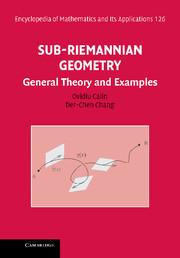Preface
Published online by Cambridge University Press: 05 May 2013
Summary
A few important discoveries in the field of thermodynamics in the 1800s made the first steps toward sub-Riemannian geometry. Carnot discovered the principle of an engine in 1824 involving two isotherms and two adiabatic processes, Jule studied adiabatic processes, and Clausius formulated the existence of the entropy in the second law of thermodynamics in 1854. In 1909 Carathéodory made the point regarding the relationship between the connectivity of two states by adiabatic processes and nonintegrability of a distribution, which is defined by the one-form of work. Chow proved the general global connectivity in 1934, and the same hypothesis was used by Hörmander in 1967 to prove the hypoellipticity of a sum of the squares of vector fields operators. However, the study of the invariants of a horizontal distribution, known as nonholonomic geometry, was initiated by the Romanian mathematician George Vranceanu in 1936.
The position of a ship on a sea is determined by three parameters: two coordinates x and y for the location and an angle to describe the orientation. Therefore, the position of a ship can be described by a point in a manifold. One can ask what is the shortest distance one should navigate to get from one position to another; this defines a Carnot–Carathéodory metric on the manifold ℝ2 × S1. In a similar way, a Carnot–Carathéodory metric can be defined on a general sub-Riemannian manifold. The study of sub-Riemannian geodesics is useful in determining the Carnot–Carathéodory distance between two points.
- Type
- Chapter
- Information
- Sub-Riemannian GeometryGeneral Theory and Examples, pp. xi - xivPublisher: Cambridge University PressPrint publication year: 2009
- 2
- Cited by

